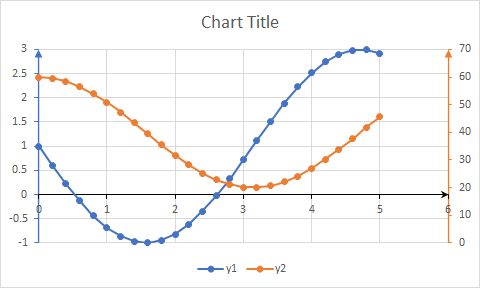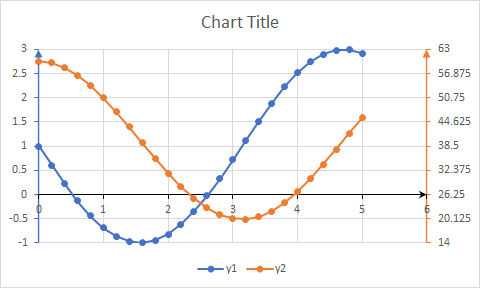从海图轴中提取最大值
从海图轴中提取最大值
提问于 2021-09-24 10:37:55
我有一个2轴的图表表,我需要提取主轴的最大值来精确地设置第二轴。我似乎不能让函数简单地读取主轴最大值,并将其放在一个单元格中,有什么想法吗?
回答 3
Stack Overflow用户
回答已采纳
发布于 2021-09-24 11:25:41
这将返回左轴的最大值,通常是原始数据的<>最大值。
Public Function getAxisMaxScale(cht As Chart) As Single
Dim ax As Axis
Set ax = cht.Axes(xlValue)
getAxisMaxScale= ax.MaximumScale
End Function若要调整可使用的二级轴,请执行以下操作
Public sub adjustAxisForChartXYZ()
Dim cht As Chart
Set cht = ThisWorkbook.Sheets("XYZ") 'insert sheetname of your chart
adjustSecondaryAxis cht
End Sub
Public Sub adjustSecondaryAxis(cht As Chart)
Dim axPrimary As Axis, axSecondary As Axis
Set axPrimary = cht.Axes(xlValue)
Set axSecondary = cht.Axes(xlValue, xlSecondary)
With axSecondary
.MajorUnit = axPrimary.MajorUnit
.MaximumScale = axPrimary.MaximumScale
End With
End Sub我也调整了MajorUnit .也要对齐
Stack Overflow用户
发布于 2021-09-24 11:23:07
在手动更改轴时记录宏将为您提供:
Sub Macro4()
'
' Macro4 Macro
'
'
ActiveSheet.ChartObjects("Chart 2").Activate
ActiveChart.Axes(xlValue).Select
ActiveChart.Axes(xlValue).MaximumScale = 60
ActiveChart.Axes(xlValue, xlSecondary).Select
ActiveChart.Axes(xlValue, xlSecondary).MaximumScale = 90
Range("L2").Select
End Sub 代码显示,您需要在工作表中的图表对象中引用图表,才能到达轴。
Sub Test()
Sheet1.ChartObjects("Chart 2").Chart.Axes(xlValue, xlSecondary).MaximumScale = _
Sheet1.ChartObjects("Chart 2").Chart.Axes(xlValue).MaximumScale
End Sub注意-可以使用变量和With.End With块缩短这段代码。
Stack Overflow用户
发布于 2021-09-24 12:31:46
这就是如何在图表中得到这两个系列的最小/最大值:
选择图表,然后运行以下命令
Dim ser as SeriesCollection
' `ChartArea.Parent` = `Chart` object
Set ser = Selection.Parent.SeriesCollection()
Dim temp1() As Variant, temp2() As Variant
temp1 = ser(1).values
temp2 = ser(2).values
' Get the data limits
Dim a_1 As Double, a_2 As Double, b_1 As Double, b_2 As Double
a_1 = WorksheetFunction.Min(temp1): a_2 = WorksheetFunction.Min(temp2)
b_1 = WorksheetFunction.Max(temp1): b_2 = WorksheetFunction.Max(temp2)这是我开发的宏的一部分,用于缩放图表的第二轴,例如滴答落在第一轴的网格上。
先于

请注意,在第二轴上,10到60的网格不是在所示的网格线上。这使得你很难读懂图表。
后

然后,调整第二轴上的网格间距以匹配主轴。此外,限制调整,以填补更好的面积。
代码
下面是我用来做这件事的代码。
Public Sub DualYAxisChart(ByRef ch As Chart)
Dim x_axis_1 As Axis, x_axis_2 As Axis, n As Long
Dim ser As SeriesCollection
Set ser = ch.SeriesCollection()
If ser.Count <> 2 Then
MsgBox "Please select a chart with two series", vbOKOnly, "Dual y-axis Chart"
Exit Sub
End If
If UBound(ser(1).values) <> UBound(ser(2).values) Then
MsgBox "Both series must share the same number of points", vbOKOnly, "Dual y-axis Chart"
Exit Sub
End If
n = UBound(ser(1).values)
ser(1).AxisGroup = xlPrimary
ser(2).AxisGroup = xlSecondary
' Enable Both Y-axes
ch.SetElement msoElementPrimaryValueAxisShow
ch.SetElement msoElementSecondaryValueAxisShow
' Enable Both X-axes
ch.SetElement msoElementPrimaryCategoryAxisShow
ch.SetElement msoElementSecondaryCategoryAxisShow
' Delete Secondary x-axis
ch.SetElement msoElementSecondaryCategoryAxisNone
Set x_axis_1 = ch.Axes(xlValue, xlPrimary)
Set x_axis_2 = ch.Axes(xlValue, xlSecondary)
x_axis_1.format.Line.ForeColor.RGB = ser(1).format.Line.ForeColor.RGB
x_axis_1.format.Line.EndArrowheadStyle = msoArrowheadTriangle
x_axis_2.format.Line.ForeColor.RGB = ser(2).format.Line.ForeColor.RGB
x_axis_2.format.Line.EndArrowheadStyle = msoArrowheadTriangle
' Auto Scale All
x_axis_1.MajorUnitIsAuto = True
x_axis_1.MaximumScaleIsAuto = True
x_axis_1.MinimumScaleIsAuto = True
x_axis_2.MajorUnitIsAuto = True
x_axis_2.MaximumScaleIsAuto = True
x_axis_2.MinimumScaleIsAuto = True
Dim a_1 As Double, a_2 As Double, b_1 As Double, b_2 As Double
Dim x_1 As Double, s_1 As Double, x_2 As Double, s_2 As Double, g_1 As Double, g_2 As Double
Dim n_1 As Long, n_2 As Long, sense As Long
' Get the axis limits
s_1 = x_axis_1.MinimumScale
x_1 = x_axis_1.MaximumScale
g_1 = x_axis_1.MajorUnit
n_1 = CLng((x_1 - s_1) / g_1)
s_2 = x_axis_2.MinimumScale
x_2 = x_axis_2.MaximumScale
g_2 = x_axis_2.MajorUnit
n_2 = CLng((x_2 - s_2) / g_2)
Dim temp1() As Variant, temp2() As Variant
temp1 = ser(1).values
temp2 = ser(2).values
' Get the data limits
a_1 = WorksheetFunction.Min(temp1): a_2 = WorksheetFunction.Min(temp2)
b_1 = WorksheetFunction.Max(temp1): b_2 = WorksheetFunction.Max(temp2)
sense = Sgn((b_2 - a_2) / (b_1 - a_1))
If sense < 0 Then
x_axis_2.ReversePlotOrder = True
Swap a_2, b_2
x_axis_2.format.Line.EndArrowheadStyle = msoArrowheadNone
x_axis_2.format.Line.BeginArrowheadStyle = msoArrowheadTriangle
End If
x_axis_1.MinimumScale = a_1: x_axis_1.MaximumScale = b_1
g_1 = x_axis_1.MajorUnit
n_1 = CLng((x_1 - s_1) / g_1)
x_axis_2.MinimumScale = a_2: x_axis_2.MaximumScale = b_2
g_2 = x_axis_2.MajorUnit
n_2 = CLng((x_2 - s_2) / g_2)
g_2 = (x_2 - s_2) / n_1
x_axis_2.MajorUnit = g_2
Dim i_1 As Long, i_2 As Long
i_1 = WorksheetFunction.Floor_Math(a_1 / g_1)
s_1 = i_1 * g_1
i_2 = WorksheetFunction.Floor_Math(a_2 / g_2)
s_2 = i_2 * g_2
Dim j_1 As Long, j_2 As Long
j_1 = WorksheetFunction.Ceiling_Math(b_1 / g_1)
x_1 = j_1 * g_1
j_2 = WorksheetFunction.Ceiling_Math(b_2 / g_2)
x_2 = j_2 * g_2
x_axis_1.MinimumScale = s_1: x_axis_1.MaximumScale = x_1
x_axis_2.MinimumScale = s_2: x_axis_2.MaximumScale = x_2
x_axis_1.MajorUnitIsAuto = True
g_1 = x_axis_1.MajorUnit
n_1 = CLng((x_1 - s_1) / g_1)
g_2 = (x_2 - s_2) / n_1
x_axis_2.MajorUnit = g_2
End Sub页面原文内容由Stack Overflow提供。腾讯云小微IT领域专用引擎提供翻译支持
原文链接:
https://stackoverflow.com/questions/69313611
复制相关文章
相似问题

